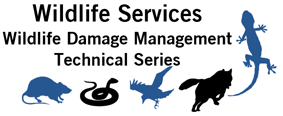United States Department of Agriculture: Animal and Plant Health Inspection Service

Wildlife Damage Management Technical Series
Date of this Version
9-2017
Document Type
Article
Citation
Homan, H.J., R.J. Johnson, J.R. Thiele, and G.M. Linz. 2017. European Starlings. Wildlife Damage Management Technical Series. USDA, APHIS, WS National Wildlife Research Center. Ft. Collins, Colorado. 26p.
Abstract
European starlings (Sturnus vulgaris, Figure 1) are an invasive species in the United States. The first recorded release of the birds was in 1890 in New York City’s Central Park. Because starlings easily adapt to a variety of habitats, nest sites and food sources, the birds spread quickly across the country. Today, there are about 150 million starlings in North America. Conflicts between people and starlings occur mostly in agricultural settings. Conflicts can occur during winter in urban and suburban environments, especially in business districts.
Starlings damage apples, blueberries, cherries, figs, grapes, peaches, and strawberries. Besides causing direct losses from eating fruits, starlings peck and slash at fruits, reducing product quality and increasing the fruits’ susceptibility to diseases and crop pests (Figure 2).
Starlings gather at concentrated animal feeding operations (CAFOs) during late fall and winter. Flocks are much larger than those encountered in late summer and are harder to disperse because of a lack of alternative foods. Starlings prefer facilities with open feeder systems which provide easy access to livestock rations (Figure 5).
The link between starlings and livestock health is beginning to be understood. Epidemiological evidence suggests that starlings are both biological vectors (e.g., fecal matter) and mechanical vectors (e.g., feet, beaks) of pathogens. Starlings can transmit or amplify several bacterial, fungal, parasitical and viral pathogens. Starlings carry Salmonella spp., several Escherichia coli serotypes, Campylobacter jejuni, Mycobacterium avium, Chalmydophilia psittaci, Flavivirus spp. (West Nile Virus), Avulavirus spp. (Newcastle’s disease) and transmissible gastroenteritis (a coronavirus) without showing any symptoms of illness. Pathogens survive in feed troughs, watering troughs and fecal deposits, some surviving for weeks or years. Transmission to livestock occurs through fecal–oral routes, mainly ingestion or licking among animals.
Combining multiple methods that affect auditory, gustatory and visual senses is an effective approach for managing pest birds, such as starlings. Starlings quickly habituate to visual deterrents (e.g., Mylar® tape, hawk kites) and audio deterrents (e.g., recorded distress calls). You can prolong and enhance the effectiveness of deterrents by frequently changing their locations and reinforcing them with other methods, such as pyrotechnics, propane cannons, falconry, and shooting.
Included in
Behavior and Ethology Commons, Biodiversity Commons, Other Animal Sciences Commons, Other Ecology and Evolutionary Biology Commons, Population Biology Commons, Terrestrial and Aquatic Ecology Commons


Comments
US government work